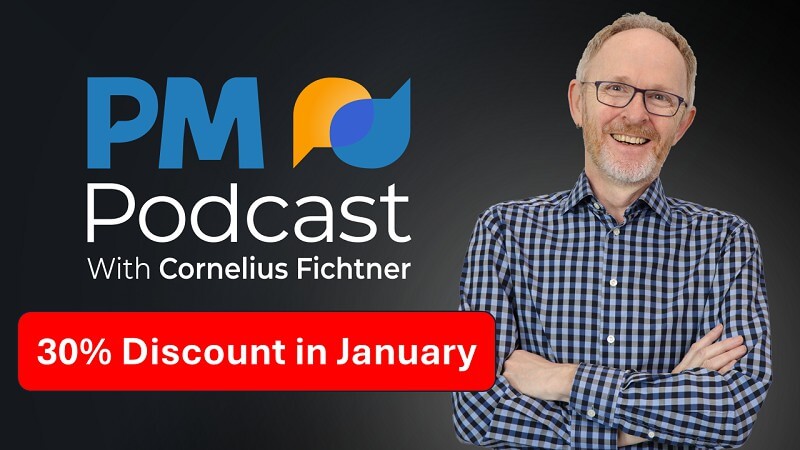Episode 382: Top Five Warning Signs that Agile Isn't Working (Free)
Studying for the Project Management Professional (PMP)® exam? Get PMP Exam Prep on any mobile device!

This interview about why Agile might be failing in your organization with NK Shrivastava was recorded at the Project Management Institute (PMI)® Global Congress 2016 in San Diego, California. We discuss his presentation and white paper Top Five Warning Signs That Agile is Not Working for You. Here are the abstract and conclusion:
Abstract: There are good possibilities of success when adopting an agile approach in an organization, but five symptoms in particular serve as warning signs that the organization’s agile transformation is not working well.
The five warning signs include: (a) no signs of value delivery for over 3 months, (b) teams resisting customer changes, (c) teams “waterfalling” sprints, (d) customers foregoing involvement in development and testing, and (e) lack of visibility for agile in the organization. Potential solutions for these problems are also described in this paper. Many organizations can solve these problems internally, but sometimes an external resource such as a change agent or an agile coach is needed. By addressing these issues, organizations can increase the chances of a successful agile transformation.
Conclusion: Agile doesn’t work by itself. Organizations that implement agile with minimal team support and expect it to work perfectly “out of the box” will likely be disappointed. Successful agile adoption depends on factors at the organization and team levels. Organizations need the right mindset, a strong commitment, a culture conducive to implement agile, and the ability to secure resources and outside help as needed. Teams need the training, skills, and empowerment to absorb and implement agile principles. With these factors in place, organizations and teams should be able to build the foundation for agile success.
As agile project management grows in popularity and use, it's important to consider what that means for us as project managers. There is no 'formal' role for a project manager in an Agile approach, but that's not to say project management isn't needed. We simply need to look for ways to provide project management, aligned with how the business works. From Scrum to Kanban, from the role of project manager in SAFe Agile and other ways of scaling, project managers have so much to offer in an agile environment.
Click to download the white paper
Episode Transcript
Below are the first few pages of the transcript. The complete transcript is available to Premium subscribers only.
Podcast Introduction
Cornelius Fichtner: Welcome everyone to the Project Management Podcast™ at www.pm-podcast.com. Once again we are coming to you live from the 2016 PMI Global Congress in sunny and very warm and humid San Diego, California. I am sitting here in the Solutions Center with NK Shrivastava.
Podcast Interview
Cornelius Fichtner: Hello, NK.
NK Shrivastava: Hello.
Cornelius Fichtner: Good afternoon.
NK Shrivastava: Good afternoon.
Cornelius Fichtner: We want to talk about your presentation, Top Five Warning Signs That Agile Is Not Working For You. Have you already given the presentation?
NK Shrivastava: Not yet.
Cornelius Fichtner: Not yet. When is it up?
NK Shrivastava: It is tomorrow at 12:45.
Cornelius Fichtner: Any idea how many people have signed up?
NK Shrivastava: Last time when I’ve inquired, it was I think about 50 people or something like that and it was even before the Congress started.
Cornelius Fichtner: Excellent. Excellen. Yeah that’s about the number that most people get in a Congress situation like this. OK. So, Top Five Warning Signs That Agile is not Working for you. Let’s go somewhere totally different. Why do organizations even want to choose to implement Agile? What’s the reasoning behind it?
NK Shrivastava: The most significant reason is about adapting to changes. Our world is changing very fast. The changes that happened last year were more than the changes that happened the previous year and so on and so forth. How do you respond to changes quickly? Agile helps you to respond to changes quickly and that’s why many, many organizations are adapting Agile so they can respond to their customer request, they respond to the changing environment, business and other environments very quickly. That’s what Agile provides.
Cornelius Fichtner: Excellent. These warning signs of trouble, what are they?
NK Shrivastava: There are so many troubles [laughs]. So, if I will start listing down probably we will have a lot but through my experience of working in Agile teams, coaching Agile teams, training Agile teams, I concluded that there are four or five things. If you see those in your teams, then most likely you’re not going to see the benefits of Agile and I’ll say if you’re not seeing the benefits of Agile then it’s not working for you.
Cornelius Fichtner: Let’s also make it clear. This is not just your opinion. This is data-driven. You put out a survey?
NK Shrivastava: Yes. We put out a survey and also I have delivered the session in other platforms. I’ll be doing a survey tomorrow real-time.
Cornelius Fichtner: OK. So that you have additional data.
NK Shrivastava: As in real-time. We will do the survey during my presentation and I want to show that result to the people right away. That will be an interesting thing you can watch that. So, yes, I have seen this and I have also talked to the people and I go in conferences and other places and work with teams. This is what I have observed and collected information. That’s how I concluded this.
Cornelius Fichtner: OK, so we’re going to go through these five warning signs one after the other. Is there anyone of these five that is more dangerous or more important than the other?
NK Shrivastava: If you’re asking what’s more important than the other, yeah. There’s importance and in my paper you will see that is how they are listed.
Cornelius Fichtner: The first one we look at is the highest, the second is the second highest and so on.
NK Shrivastava: Absolutely. The highest one is that: No signs of value delivery for three months.
Cornelius Fichtner: So the first warning sign is: No signs of value delivery for three months. Can you tell us a little bit more about that one?
NK Shrivastava: Yes. One of the things that Agile does is it makes an organization value focused whether you are delivering value to the customer or not and that is done through backlog. You have items in the backlog that’s organized in priority, highest value on the top and then you start delivery. If you are not delivering, then that value is not reaching to the customer. If you use Agile, you should start delivering value in weeks rather than months.
In some things, people have to do some infrastructure work, some ground work and that may take some time, maybe a month, maybe two months, but after that it should start delivering. If you are not delivering, then either you are in the churn process, like doing requirements, requirements, requirements, not doing it. All there is –you have so big items to deliver that you are not able to break it down into pieces and deliver. If you’re not delivering, customer is not getting the value and that’s the promise of Agile.
Cornelius Fichtner: Absolutely. What do we do about it?
NK Shrivastava: What do you do about it is go look at your backlog and see how you can divide into smaller chunks and see how you can deliver it—fully functional things that the customer can see. That’s the key thing and that’s many of the teams are not able to do. They don’t follow what is called “invest criteria” for writing user stories, which says that you have to small-size stories, independent valuable and all that. If you’re not following the invest criteria, your stories are going to be large and dependent. When the stories are dependent, then you say, “Oh, I cannot deliver this until I deliver that, until I deliver that, until I deliver”. It becomes a kind of a big thing.
Cornelius Fichtner: And you have to wait until all of these things are done.
NK Shrivastava: You have to wait until all of these things are done. The teams do not know how to write good user stories. That’s a fundamental skill that needs to be learned and practiced. That’s one of the key things of not being able to do it. The other could be that some of the organizations have organizational issues –something like that – nothing goes out to production unless it’s two months in QA. so that has to go through kind of the things so the organization’s old practices that inhibit that – and you need to look into that—why the practices? The practices are there because the big chunks of software were developed and they were given to QA for testing, they needed more time. Now it is a very small chunk of pieces that go, you don’t need two months in QA that need to be logged into that kind of organizational practices and need to change that. On one side, learning the skill of doing it other side looking at the organization’s practices. Third side is, even the infrastructure work –do we need to do all of infrastructure work? Or do we need to do only enough infrastructure work so that we can start delivering in iterations.
Cornelius Fichtner: I have another thought, maybe the project that you are doing is not suited for Agile. My example will be this: if you build a road, you can build 100 meters of road, deliver it. 100 meters of road, deliver it. So there is always some and it’s usable. People can drive on it. But if you do a swimming pool, you dig a hole but then, you can’t use it yet. You put the concrete in, you can’t use it yet. You put the paint in, you can’t use it yet. You put the water and finally, you can start using it. If you try to deliver the swimming pool in an Agile way, there is no way. You have to wait until you’re done. So maybe it was the wrong choice of methodology.
NK Shrivastava: That’s a possibility but…
Cornelius Fichtner: It’s a different discussion than what we are looking at right here.
NK Shrivastava: Yes, yes. And Agile is not a good fit for everything.
Cornelius Fichtner: Exactly.
NK Shrivastava:I have written a blog and all those—my little articles and all that. Is Agile a silver bullet? It is not.
Cornelius Fichtner: It is definitely not. [laughs] And neither is Waterfall or a plan-driven…
NK Shrivastava: Yes, yes, yeah.
Cornelius Fichtner: Yeah. Alright! So the first one was: no signs of value delivery for over three months. The second warning sign: teams resist change from the customer.
NK Shrivastava: Yeah. That’s another interesting thing I have seen that the teams will not take changes from the customer which is strange for an Agile team.
Cornelius Fichtner: And we’re not talking about during the sprint. We’re talking outside of the sprint with new feature requests and updating and changing and during the sprint, yes we don’t want to change but during the sprint as you are planning, there it’s fine.
NK Shrivastava: Yes. And I think sometimes that also I’ve seen that teams will just change during the sprint which is right during the sprint.
Cornelius Fichtner: Yes.
NK Shrivastava: But the business environment could be that you need change more frequently than the sprint duration. That’s possible.
Cornelius Fichtner: OK. Yes.
NK Shrivastava: So, in that case, you change your sprint duration. If you are doing a three-weeks sprint and you’re seeing changes…
Cornelius Fichtner: You cut it down to two, you cut it down to one
NK Shrivastava: Yeah, so that’s one thing. I’m not talking of that. I’m talking of the team including the development team, product owner and everybody. They don’t want to do this.
Cornelius Fichtner: No, no. The backlog is fixed, we cannot change the backlog. Leave the backlog alone.
NK Shrivastava: Yeah. Backlog grooming is something that needs to happen on a regular basis. People say, “We don’t have time to do backlog grooming”. In some cases I have seen where they are not product owners associated with the thing so it becomes difficult. That’s the case where teams are doing Agile but not being Agile. They are doing sprint, they are doing the least and they’re doing all of these things but they have not internalized the mindset. They have not.
Cornelius Fichtner: They haven’t really bought into the mindset. And is that the solution? We have to go back to the values, we have to teach our team the values, we have to really go back there and say this is what Agile is all about.
NK Shrivastava: Yeah and I think it’s that and also as human beings, we don’t like changes. [Laughs]
Cornelius Fichtner: That’s true.
NK Shrivastava: Nobody likes changes. Training us to not to be bothered about changes. I think that’s very important and Agile mindset is about responding to change. The other one that teams may not be empowered even sometimes to do the changes. Teams may want to do changes but they may not be empowered to bring it in and work on their own. They may have some middle manager who is still controlling the team and he may not lead them—if the changes happen, then he may ask questions. Why did he do this change?
Cornelius Fichtner: Again, not understanding the Agile approach.
NK Shrivastava: Approach. Not understanding what Agile really means. Doing Agile but not being Agile. I think that’s the key part there.
Cornelius Fichtner: So those were the first two: No signs of value delivery for three months followed by team resists change from the customer and we’re moving on to the third one here: teams are Waterfalling their sprints. What does that mean?
Above are the first few pages of the transcript. The complete PDF transcript is available to Premium subscribers only.
PDUs: Business Acumen, Podcast Episodes About Agile, Agile Project Management, PMI Global Congress, PMI Global Congress NA 2016, Podcast Episodes About Scrum


